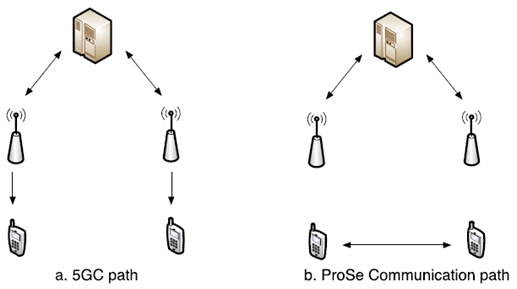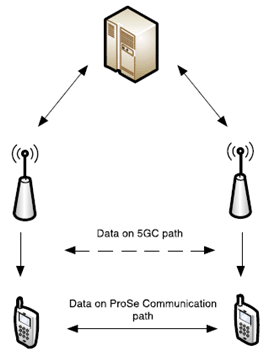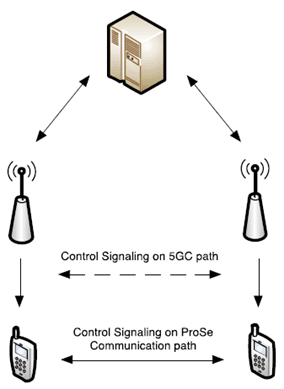Content for TR 22.842 Word version: 17.2.0
1 Scope
2 References
3 Definitions and abbreviations
3.1 Definitions
3.2 Abbreviations
4 Overview
...
...
1 Scope p. 6
With the expectation that 5G consumer UEs, existing or some new form devices (e.g. VR/AR devices, robot, etc.) being used for different use cases in a number of different environments, e.g. entertainment in home party or bar, or education in office, becomes interested for supporting data sharing and data exchanging between users, thus, it is necessary to investigate new use cases and requirements, like lower latency, higher throughput, higher reliability, higher resource/power efficiency etc, for such interactive services.
The objective of this TR is to study the use cases and to derive potential service requirements to provide users with interactive services, including:
- New use cases and new requirements for Interactive Services
- Gap Analyses between requirements and existing eMBB service requirements / existing ProSe requirements
- After the use cases have been identified, service requirements and KPIs will be studied including QoS, operator control, charging, etc.
2 References p. 6
The following documents contain provisions which, through reference in this text, constitute provisions of the present document.
- References are either specific (identified by date of publication, edition number, version number, etc.) or non-specific.
- For a specific reference, subsequent revisions do not apply.
- For a non-specific reference, the latest version applies. In the case of a reference to a 3GPP document (including a GSM document), a non-specific reference implicitly refers to the latest version of that document in the same Release as the present document.
[1]
TR 21.905: "Vocabulary for 3GPP Specifications".
[2]
TR 22.891: Feasibility Study on New Services and Markets Technology Enablers
[3]
TR 22.863: Feasibility study on new services and markets technology enablers for enhanced mobile broadband
[4]
TS 22.261: Service requirements for the 5G system
[5]
Augmented and Virtual Reality: the First Wave of 5G Killer Apps, ABI research and Qualcomm;
[6]
O. Abari, D. Bharadia, A. Duffield, and D. Katabi, "Cutting the Cord in Virtual Reality," in Proceedings of the 15th ACM Workshop on Hot Topics in Networks. ACM, 2016, pp. 162-168.
[7]
E. Bastug, M. Bennis, M. Médard, and M. Debbah, "Toward Interconnected Virtual Reality: Opportunities, Challenges, and Enablers," IEEE Communications Magazine, vol. 55, no. 6, pp. 110-117, 2017.
[8]
Athul Prasad, Mikko A. Uusitalo, David Navrátil, and Mikko Säily, "Challenges for Enabling Virtual Reality Broadcast Using 5G Small Cell Network", IEEE Wireless Communications and Networking Conference Workshops, pp. 220-225, 2018.
[9]
Mohammed S. Elbamby, Cristina Perfecto, Mehdi Bennis, and Klaus Doppler, "Toward Low-Latency and Ultra-Reliable Virtual Reality", IEEE Network, March/April, 2018.
[10]
Orlosky, Jason & Kiyokawa, Kiyoshi & Takemura, Haruo, "Virtual and Augmented Reality on the 5G Highway", Journal of Information Processing, 25. 133-141. 10.2197/ipsjjip.25.133.
[11]
J. Huang, Z. Chen, D. Ceylan and H. Jin, "6-DOF VR videos with a single 360-camera", 2017 IEEE Virtual Reality (VR), Los Angeles, CA, 2017, pp. 37-44. doi: 10.1109/VR.2017.7892229.
[12]
Impact of Packet Losses on the Quality of Video Streaming, https://www.diva-portal.org/smash/get/diva2:831420/FULLTEXT01.pdf
[13]
New Study from GSMA and CAICT Forecasts That China Will Be the World's Largest 5G Market by 2025, https://www.webscalenetworking.com/news/2017/06/27/8571173.htm
[14]
TR 22.803: Feasibility study for Proximity Services (ProSe)
[15]
TS 22.278: Service requirements for the Evolved Packet System (EPS)
[16]
TR 22.821: Feasibility Study on LAN Support in 5G
[17]
Gaming in the cloud: one of the future entertainment, https://pdfs.semanticscholar.org/c874/432461d2fa71cea23f9404c02d571acc8d74.pdf
[18]
TS 22.468: Group Communication System Enablers (GCSE)
[19]
TS 22.104: Service requirements for cyber-physical control applications in vertical domains
3 Definitions and abbreviations p. 7
3.1 Definitions p. 7
For the purposes of the present document, the terms and definitions given in TR 21.905 and the following apply. A term defined in the present document takes precedence over the definition of the same term, if any, in TR 21.905.
NCIS Service:
One kind of service which needs at least more than one UEs to join and share data, e.g. interactive gaming or data sharing.
NCIS Session:
all UEs in one session can have same information of the background, status and update.
NCIS Group:
Those UEs in the same NCIS session are grouped together as one NCIS group, and the group is determined by application layer.
Guaranteed Data Rate:
The minimum data rate which is different from peak data rate or average data rate.
ProSe Communication path:
the communication path supporting ProSe Communication.
5GC path:
the user plane communication path through 5GC.
End-to-End Latency:
the time that takes to transfer a given piece of information from a source to a destination, measured at the communication interface, from the moment it is transmitted by the source to the moment it is successfully received at the destination.
Communication Service Interface:
The interface between application/function and 5G system.
Reliability:
in the context of network layer packet transmissions, percentage value of the amount of sent network layer packets successfully delivered to a given system entity within the time constraint required by the targeted service, divided by the total number of sent network layer packets.
Visual content:
The visual part content of the interactive service, e.g. gaming.
3.2 Abbreviations p. 8
4 Overview p. 9
In [14], the feasibility study of Proximity Service has been done, and requirements have been specified in [15].
However, with the development of some new form devices (e.g. VR/AR devices, robot, etc.) or some new technologies (e.g. AR and VR), new service for people to exchange information and play game will become more and more popular (i.e. NCIS: Network Controlled Interactive Service). In this case, additional service requirements could be defined on top of [14] and [15].
A lot of interactive services happen in local area e.g. entertainment in home party or bar, or education in office, or cloud/edge/split rendering at local, and the requirements for throughput, latency, reliability and resource/power utilization could be enhanced with specific the ProSe Communication path (i.e. direct between ProSe UEs) or the 5GC path between users.
In this section, we provided the possible data path and control path with taking into account the content in [15] as a baseline.

Figure 4-1: Existing path: (a) 5GC path (b) ProSe Communication path (directly between ProSe-enabled UEs)
(⇒ copy of original 3GPP image)
(⇒ copy of original 3GPP image)
However, for NCIS service to achieve improved throughput and rigid latency, the data path could be the combination of the above two as indicated in Figure 4-2.

Figure 4-2: Data path of 5GC path and ProSe Communication path (directly between ProSe-enabled UEs)
(⇒ copy of original 3GPP image)
(⇒ copy of original 3GPP image)
For NCIS service, the control path mentioned in [15] could also be taken as the baseline. In this case, the key control signalling will be from the network, while some assistance signalling on the ProSe Communication path (direct) could be exchanged between users.

Figure 4-3: Control path of 5GC path and ProSe Communication path (directly between ProSe-enabled UEs)
(⇒ copy of original 3GPP image)
(⇒ copy of original 3GPP image)
Based on the above description and current network architecture, the control path and data path could use the same frequency or different frequencies as indicated in Figure 4-4.

When operator using the same frequency, all the control signalling could be carried in the 5GC Path, while some data could be carried in the ProSe Communication path (direct) if needed for offloading.
When operator using the different frequencies (e.g. F1 and F2), in some places where infrastructure for F2 is not deployed, all control signalling could be carried in the 5GC Path on F1 which can be fully controlled by operator, while some data could be carried in the ProSe Communication path (direct) on F2 to improve the resource utilization and user experience.